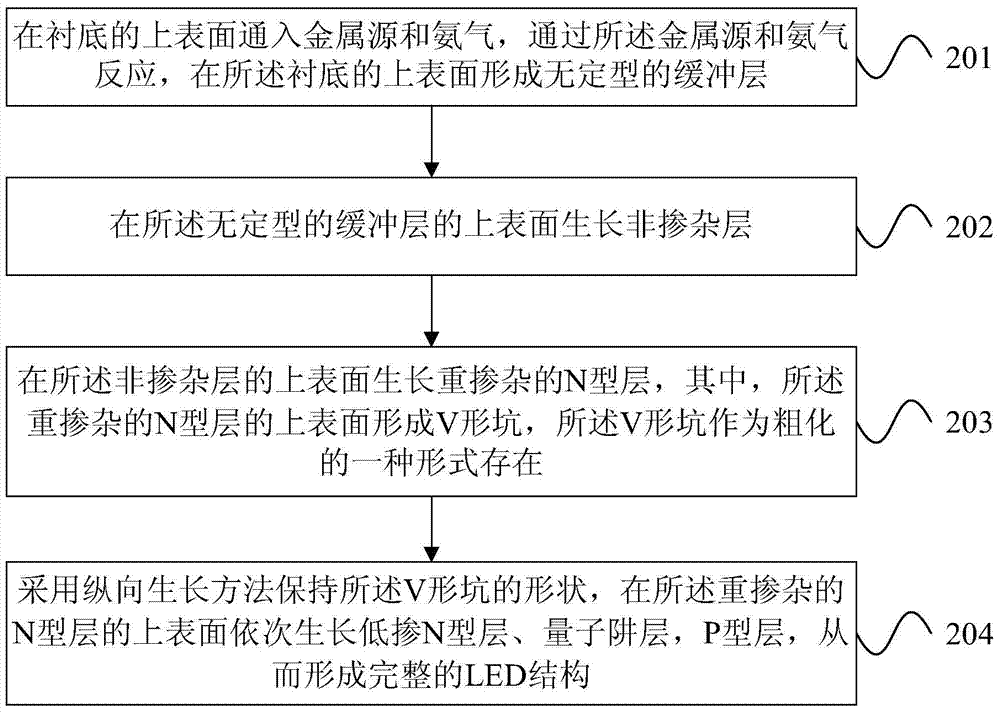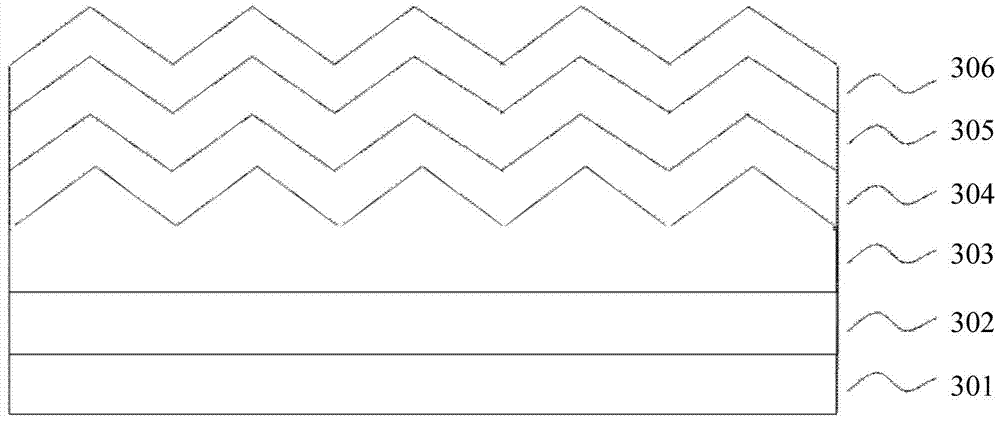LED growth method with n-type layer coarsening
A growth method, N-type technology, applied in the direction of electrical components, circuits, semiconductor devices, etc., to achieve the effect of improving light extraction efficiency, realizing industrialization, and simple and easy roughening method
- Summary
- Abstract
- Description
- Claims
- Application Information
AI Technical Summary
Problems solved by technology
Method used
Image
Examples
Embodiment 1
[0050] GaN blue LED with roughened N-type layer
[0051] 1. On the Veeco MOCVD K465I machine, use a patterned sapphire substrate. When the surface temperature of the substrate material 301 rises to about 530°C, keep the growth pressure at 500 Torr. Pass trimethylgallium (60ml / min) and ammonia gas (NH 3 )50l / min for 3 minutes, trimethylgallium and NH 3 At this temperature, it decomposes and reacts chemically to form an amorphous buffer layer with a thickness of 20nm.
[0052] 2. Increase the temperature of the reaction chamber to 1000°C. At this time, the buffer layer undergoes decomposition and polymerization to form uniformly distributed nucleation islands. Then, on this basis, the pressure is maintained at 500 Torr, and trimethylgallium (200ml / min) and NH 3 50l / min reaction for 30 minutes. This growth process can make the crystal nucleus islands grow and merge, without doping any impurities to form the undoped GaN layer 302 . The thickness of this layer is approximately...
Embodiment 2
[0059] GaN green LED with roughened N-type layer
[0060] 1. On the Veeco MOCVD K465I machine, use a patterned sapphire substrate. When the surface temperature of the substrate material 301 rises to about 530°C, keep the growth pressure at 500 Torr. Pass trimethylgallium (60ml / min) and ammonia gas (NH 3 )50l / min for 3 minutes, trimethylgallium and NH 3 At this temperature, it decomposes and reacts chemically to form an amorphous buffer layer with a thickness of 20nm.
[0061] 2. Increase the temperature of the reaction chamber to 1000°C. At this time, the buffer layer undergoes decomposition and polymerization to form uniformly distributed nucleation islands. Then, on this basis, the pressure is maintained at 500 Torr, and trimethylgallium (200ml / min) and NH 3 50l / min reaction for 30 minutes. This growth process can make the crystal nucleus islands grow and merge, without doping any impurities to form the undoped GaN layer 302 . The thickness of this layer is approximatel...
PUM
 Login to View More
Login to View More Abstract
Description
Claims
Application Information
 Login to View More
Login to View More - R&D
- Intellectual Property
- Life Sciences
- Materials
- Tech Scout
- Unparalleled Data Quality
- Higher Quality Content
- 60% Fewer Hallucinations
Browse by: Latest US Patents, China's latest patents, Technical Efficacy Thesaurus, Application Domain, Technology Topic, Popular Technical Reports.
© 2025 PatSnap. All rights reserved.Legal|Privacy policy|Modern Slavery Act Transparency Statement|Sitemap|About US| Contact US: help@patsnap.com



